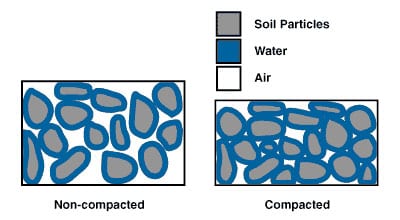.........................................................................................................................................................
By: Haseeb Jamal
Factors Affecting Soil Compaction
Following are the factors affecting Soil Compaction:
· Water content of
the soil at the time of compaction.
· Nature and the type
of soil being compacted like sand or clay, grading, plasticity
· Site conditions,
e.g. weather, type of site, layer thickness
Effects of different factors on compaction of soil
Effect of Water content on compaction of soil:
As water is added to a soil (at low moisture content) it becomes
easier for the particles to move past one another during the application of the
compacting forces.
As the soil compacts, the voids are reduced and this causes the
dry unit weight (or dry density) to increase. Then, as the moisture content
increases so does the dry unit weight.
However, the increase cannot occur indefinitely because the soil
state approaches the zero air voids line which gives the maximum dry unit
weight for a given moisture content.
Thus, as the state approaches the zero air voids line further
moisture content increase must result in a reduction in dry unit weight.
As the state approaches the no air voids line a maximum dry unit
weight is reached and the moisture content at this maximum is called the optimum
moisture content.
Increased compactive effort
Increased compactive effort enables greater dry unit
weights to be achieved. Because of the shape of the no air voids line, the dry
unit weights must occur at lower optimum moisture contents.
It should be noted that for moisture contents greater than
the optimum the use of heavier compaction machinery will have only a small
effect on increasing dry unit weights.
For this reason, it is important to have good control over
moisture content during compaction of soil layers in the field.
Effects of Soil type on Compaction of Soil
Normally, heavy clay, clay & silt offer higher
resistance to compaction whereas sandy soils and coarse grained or gravelly
soils can be easily compacted.
The coarse-grained soils yield higher densities in
comparison to clay. It should also be noted that a well graded soil can be
compacted to higher density.
The table below contains typical values for the different soil
types obtained from the Standard Compaction Test.
Typical Compaction Values
| ||
Type of Soil
|
(gdry) max (kN/ m3)
|
mopt (%)
|
Well graded sand SW
|
22
|
7
|
Sandy clay SC
|
19
|
12
|
Poorly graded sand SP
|
18
|
15
|
Low plasticity clay CL
|
18
|
15
|
Non plastic silt ML
|
17
|
17
|
High plasticity clay CH
|
15
|
25
|
Note that these are typical values. Because of the
variability of soils, it is not appropriate to use typical values in design,
tests are always required.
Haseeb
Jamal. I am a Civil Engineer,
graduated from University
of Engineering and Technology, Peshawar, Pakistan in 2010. I also
have a PG-Diploma in Disaster Management and
MS in Urban
Infrastructure Engineering (In Progress). My expertise include civil
related softwares like AutoCAD,
SAP2000, MS Project, Primavera, MS Office and GIS. My technical skills include
project management, monitoring and evaluation, structural assessment, disaster risk
management, Quantity survey, land survey, material testing, site management and
technical writing. I am trained in writing project progress reports as well as
proposals and concept papers. I have also received advanced training on
surveying, proposal writing, Monitoring and Evaluation of projects as well as
organizations.
I have worked as Project
Engineer at National Research and Development Foundation, Peshawar and
CENCON Associates. I also worked with Spectra Engineering Solutions as Senior
Civil Engineer in monitoring of World Bank and UNDP funded projects all
over Khyber Pakhtunkhwa and FATA. Currently, I am working as Deputy
Manager Development at NayaTel, Peshawar.


No comments:
Post a Comment